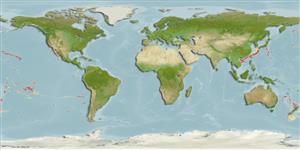>
Pleuronectiformes (Flatfishes) >
Bothidae (Lefteye flounders)
Etymology: Chascanopsetta: Greek, chaskanon, -ou = a mask used in classicla Greek theatre with the mouth opened + Greek, psetta = grouper (Ref. 45335).
More on author: Gilbert.
Environment: milieu / climate zone / depth range / distribution range
Ekologi
laut batidemersal; kisaran kedalaman 267 - 400 m (Ref. 11412). Deep-water
Northwest Pacific: Midway Islands and Emperor Seamount. Eastern Central Pacific: Hawaii.
Size / Weight / umur
Maturity: Lm ? range ? - ? cm
Max length : 3.0 cm SL jantan/; (Ref. 11412)
Benthic on sand (Ref. 58302).
Life cycle and mating behavior
Kematangan | Reproduksi, perkembang biakan | Pemijahan | telur-telur | Fecundity | Larva
Amaoka, K. and E. Yamamoto, 1984. Review of the genus Chascanopsetta, with the description of a new species. Bull. Fac. Fish. Hokkaido Univ. 35(4):201-224. (Ref. 11412)
Status IUCN Red List (Ref. 130435: Version 2024-2)
ancaman kepada manusia
Harmless
penggunaan manusia
Alat, peralatan
laporan khas
muat turun XML
Sumber internet
Estimates based on models
Preferred temperature (Ref.
123201): 3.4 - 6.5, mean 4.6 °C (based on 86 cells).
Phylogenetic diversity index (Ref.
82804): PD
50 = 0.5039 [Uniqueness, from 0.5 = low to 2.0 = high].
Bayesian length-weight: a=0.00759 (0.00355 - 0.01619), b=3.08 (2.90 - 3.26), in cm total length, based on LWR estimates for this (Sub)family-body shape (Ref.
93245).
Trophic level (Ref.
69278): 3.2 ±0.4 se; based on size and trophs of closest relatives
Daya lenting (Ref.
120179): sedang, Waktu penggandaan populasi minimum 1.4 - 4.4 tahun (Assuming tmax>3).
Fishing Vulnerability (Ref.
59153): Low vulnerability (10 of 100).
